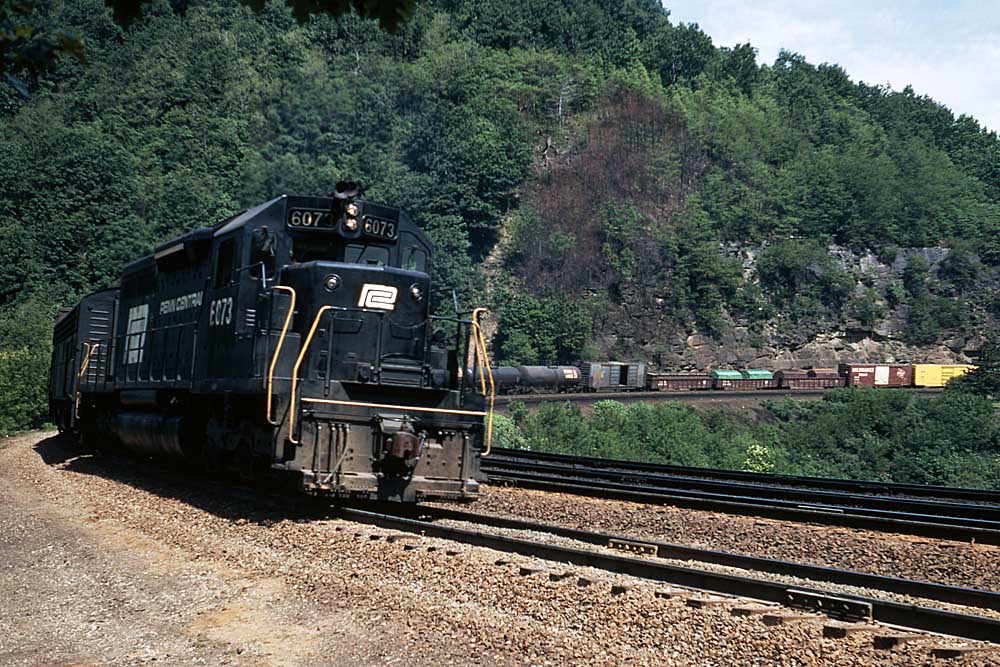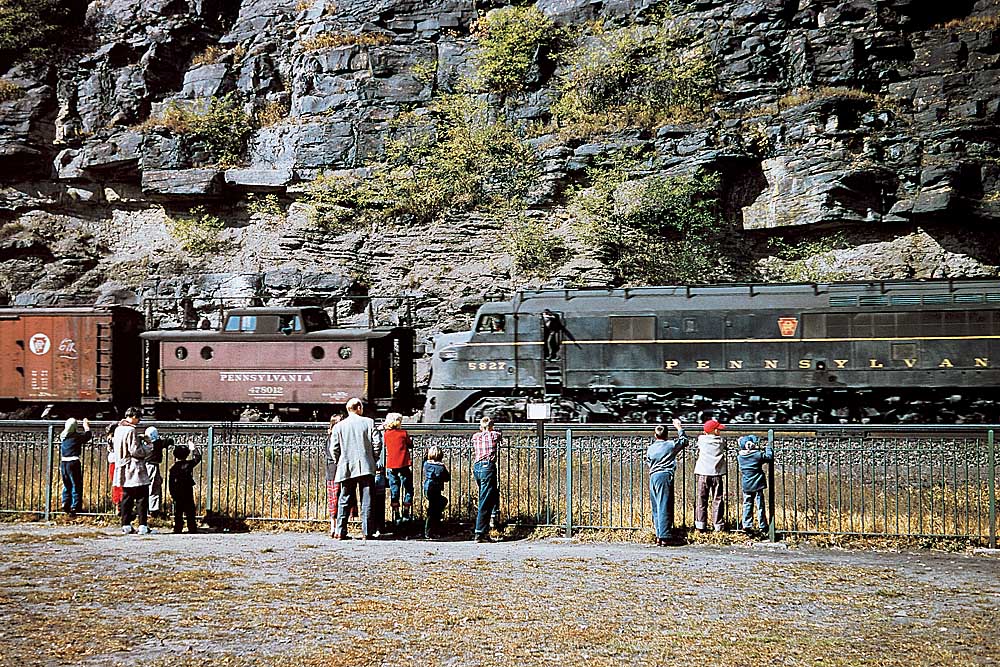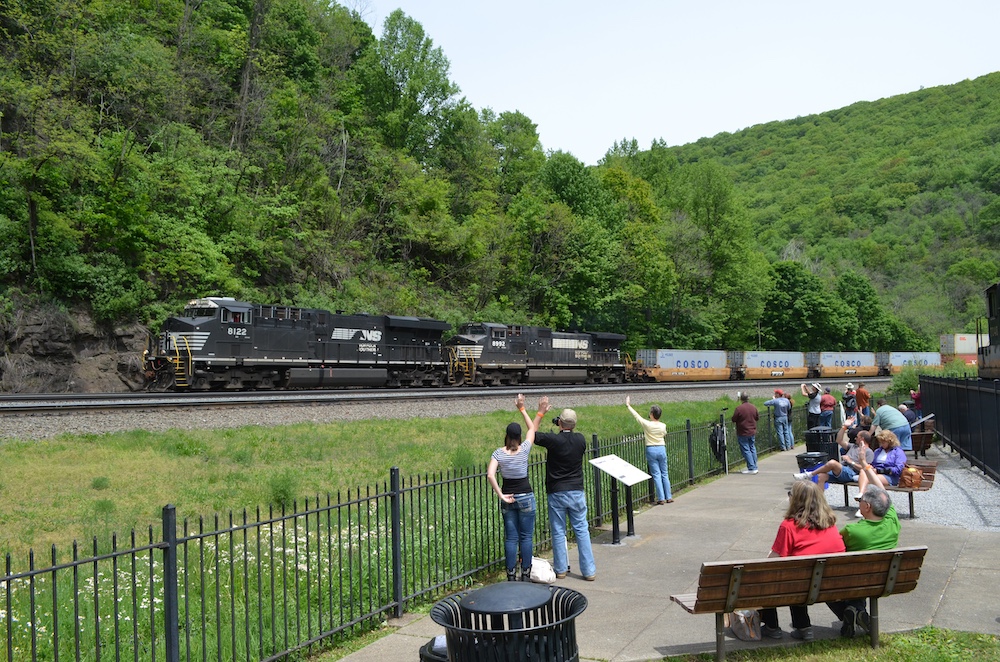
Mention the name, “horseshoe curve,” and your mind will immediately think of the World Famous Horseshoe Curve nestled deep in the Allegheny Mountains west of Altoona, Penn. That shouldn’t be a surprise considering this landmark’s history and engineering marvel that’s been attracting visitors for 170 years, ranging from the curious to the most enthusiastic.
When the Pennsylvania Railroad looked to connect Pittsburgh with Harrisburg as part of its 1846 charter, what stood between the fledgling railroad and potential westward expansion was the Allegheny Mountains. While the Allegheny Tunnel at Gallitzin was one solution to traverse the rugged terrain standing tall at 2,161 feet above sea level, another was a horseshoe-style curve to help ease the gradient, which would reach a maximum of 1.86% along the route.
Pennsy chief engineer J. Edgar Thomson headed the project. The set location for the curve at Kittanning Point was the result of a dozen passage options being surveyed. The four-year slog to carve through the Alleghenies began in 1850 and was made possible by the hard work of Irish immigrants hired by the Pennsylvania Railroad. The Horseshoe Curve, and ultimately the new Pittsburgh-Harrisburg main line, opened on February 15, 1854. From there grew a legendary railroad that would stretch well into the U.S. history books beyond its eventual 10,000-mile network.
When completed, the curve became renowned as one of the eight engineering marvels of the world. It resides between 1,500 and 1,900 feet of elevation with an incline of 1.73-1.75% heading west — including a brief 1.45% at the center. While the original routing and alignment remains the same, the line has been a primary candidate for improvements and expansion over the years. Block signals were introduced in 1875, followed by automatic block signaling in 1900. While the original double-track main line was triple-tracked in 1898, and then quadruple-tracked in 1900 — though track No. 2 would eventually be removed in 1981 by PRR successor Conrail.

It wasn’t long until Horseshoe Curve caught the attention of many wishing to witness this marvel and its scenic beauty. The Pennsylvania Railroad didn’t shy away from promotional opportunities upon completing significant landscaping to the area in 1879. The completion of a macadam road in 1932 also became a game changer as it provided easier access to the curve. In 1967, Horseshoe Curve was designated as a National Historic Landmark.
The inside of the curve eventually set the stage for a park-like destination as tourism to the area increased at the end of World War II. Over the years, the site has seen additions and improvements for the visitor’s experience, including a gift shop in 1940 and multiple pieces of displayed equipment with Altoona-built K4-class 4-6-2 No. 1361 as the most prominent. A significant addition came in the form of a $5.8 million visitor center that was supported by both the state and the National Park Service. Completed in 1992, the facility includes a funicular to complement the 10-story stairway for viewing the curve at track level. The overall site is managed today by Altoona’s Railroaders Memorial Museum.
The curve, itself, remains active and serves as a vital connection in modern-day railroading. After the Pennsylvania Railroad days ended in 1968, the landmark has seen three additional owners: Penn Central, 1968-1976; Conrail, 1976-1999; and currently, Norfolk Southern Corp. Today, roughly 50 freight and helper movements by NS and one Amtrak service traverse what is now the Pittsburgh Line with the passenger rail carrier’s New York-Pittsburgh Pennsylvanian train making a station stop in Altoona.
The late Trains and Classic Trains Senior Editor J. David Ingles and his friend Dick Wallin visited the World Famous Horseshoe Curve in 1969.

— Updated Nov. 1, 2024, with correct information on the lead caption, charter dates, grade percentages, and modern-day traffic.














You can watch live action of the curve 24/7 at:
https://www.youtube.com/watch?v=ssuM6NJQ2no
Cheers,
Jeff Damerst
Good news.
If I’m up to it, I’ll visit next spring.
I’ve been waiting patiently for years for them to fix the incline railway. I’m in my 80’s, disabled, and I wish I could see the curve up close.
It was just recently announced that after five years of work, the funicular has been reopened.
Second paragraph, I believe you meant to say “1850’s “.